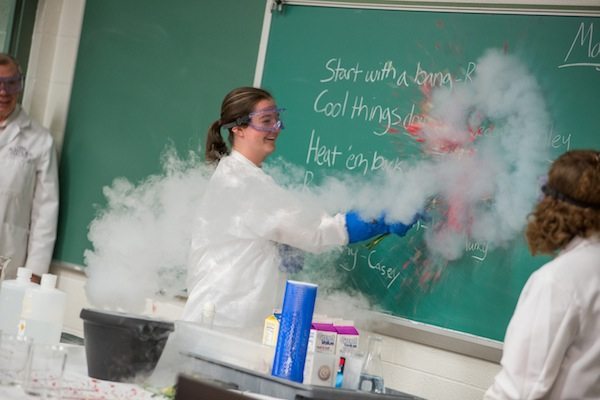
This test is no longer offered.
Update March 22, 2020: While SAT Subject Tests™ are getting phased out by many colleges and universities (see recent announcements from Cornell and MIT), there is some speculation that the SAT Subject tests will have greater weight this year because so many schools are going pass fail for the balance of the year. We suggest discussing with your individual college counselors.
We are available for private and group tutoring for the SAT Chemistry Subject Test.
We are writing this on Sunday May 10 and June 6 is less than 4 weeks away. Is it too late to start preparing for the SAT Chemistry Subject test? Four weeks!!! How are you going to learn all that chemistry? Well, the answer is, you already have learned all that chemistry; you studied Boyle’s Law, equilibrium constants, and stoichiometry all year. So a good amount of your practice is just reviewing those subjects, and doing tons of problems. Which problems should you pay the most attention to? Since the difficulty of these tests tends to lie in the breadth, rather than the depth, of the material, you should neglect the problems toward the end of the chapter that look like they will take an hour to do, and pay attention to the worked problems in your textbook – the ones that show you how to approach a problem in a step by step fashion. Not only are they the most informative in terms of how to approach the problem, but if the textbooks take the time to show you how to do them in rigorous detail, you can bet they are fundamental pillars of your course.
So preparation will involve problem heavy review (don’t just reread text and try to understand concepts) together with some test taking techniques. Depending on where your course finishes up, it is not likely you have to learn a lot of new material, although that does depend: Ideally your course covered through electrochemistry and the beginnings of organic chemistry, but even if it didn’t, you may still know enough to score well. Which brings up the curve: The “curve” on the Chemistry SAT is more forgiving than it is for the SAT in Biology, for which you have to get a very high percentage correct in order to score an 800. But what if your course did not cover enough material? Your class should get through, at least, the end of acid base equilibria and solubility products. If it didn’t, you may wish to rethink things, because you will have quite a bit of material to learn. Let me stress this point: if your course did not finish up acid base equilibira and solubility, you are really far behind the eight ball. I would advise against attempting this test.
How about your math skills? The Chemistry subject test has a reputation as rigorous in this regard. Despite the more quantitative nature (relative, say, to the SAT Biology), the SAT Chemistry test requires less math and algebra than the actual math classes the kids are usually enrolled in. Oh and remember, there are no calculators allowed, so start practicing without them. This by the way is a subject for some future blog, but kids are way too dependent on calculators, and will run to them when they have to multiply 0.25 x 1 (I have seen this, no joke). The numbers they give you, though, tend to be “easy” to work with. Just be able to manipulate logs, which is easier than it sounds, and definitely easier than lifting actual logs.
So those are some general facts; now let’s look at the format of the test: it is all multiple choice with the exception of the middle part, and is 85 questions in total divided into three sections. You have an hour, like all SAT Subject tests. Remember, knowing the nature of the test, and test taking skills, will not help you score highly if you do not know the material! So you C+ students? You are way better off trying to improve your course grade. But let’s look at the format:
Section 1 consists of “matching “sets, which will have 3 – 7 statements preceded by 5 answer choices, A-E. For example,
Questions7-9
A) Has a low first ionization energy
B) A molecule with SP![]() hybrid
hybrid
orbitals
C) Contains only non polar bonds
D) A Lewis acid
E) A molecule containing SP hybrid
orbitals
7) C2H2 (select A – E)
8) CH3COCH3 (select A – E)
9) BF3 (select A – E)
These generally go up through question 23 – 26.
Section II (which, just to keep things interesting, starts at question 101 and goes through ~115) consists of a series of 14 – 16 questions in which the first statement is either T or F, the second statement is T or F, and then you decide if statement II is because of statement I. If so, you bubble in the correct explanation bubble.
For example:
| I | II | CE |
| A molecule of CCl4 is non polar | The four bonds are identical and the molecule has a tetrahedral structure |
So is statement I true or false?
Is statement II true or false, and if statement II is because ofstatement I, you fill in the bubble for CE, ”Correct Explanation”.
Section III is straight multiple choice, and there will be ~ 45 of them. The test ends on question 70.
But let’s return to what where we began. When, exactly, is it too late to start preparing? The answer is that you can learn effective techniques the night before the test that can help you. Obviously you will not have the time to practice them but if you know your chemistry, there are paradigms we can show you that can help immediately. There is no one answer that applies to all kids but if your course fundamentals are solid then it is never too late too review some skills specific to the Chemistry Subject test and improve your odds for a great score.
Be sure to give us a shout if you have any questions!
SAT Subject TestsTM is a trademark registered and/or owned by the College Board, which was not involved in the production of, and does not endorse, Warp Drive Tutors.
